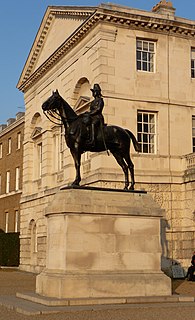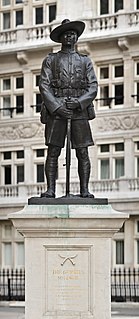
Field Marshal Colin Campbell, 1st Baron Clyde,, was a British Army officer. After serving in the Peninsular War and the War of 1812, he commanded the 98th Regiment of Foot during the First Opium War and then commanded a brigade during the Second Anglo-Sikh War. He went on to command the Highland Brigade at the Battle of Alma and with his "thin red line of Highlanders" he repulsed the Russian attack on Balaclava during the Crimean War. At an early stage of the Indian Mutiny, he became Commander-in-Chief, India and, in that role, he relieved and then evacuated Lucknow and, after attacking and decisively defeating Tatya Tope at the Second Battle of Cawnpore, captured Lucknow again. Whilst still commander-in-chief he dealt with the "White Mutiny" among East India Company troops, and organised the army sent east in the Second Opium War.

Major-General William McBean was a Scottish recipient of the Victoria Cross, the highest and most prestigious award for gallantry in the face of the enemy that can be awarded to British and Commonwealth forces.

Major-General Sir Robert Henry Sale was a British Army officer who commanded the garrison of Jalalabad during the First Afghan War and was killed in action during the First Anglo-Sikh War.
The 97th Regiment of Foot was an infantry regiment of the British Army, formed in 1824 and amalgamated into the Queen's Own in 1881.

The 90th Perthshire Light Infantry was a Scottish light infantry regiment of the British Army, raised in 1794. Under the Childers Reforms it amalgamated with the 26th (Cameronian) Regiment of Foot to form the Cameronians in 1881.
The 104th Regiment of Foot was a regiment of the British Army, raised by the Honourable East India Company in 1765. Under the Childers Reforms it amalgamated with the 101st Regiment of Foot to form the Royal Munster Fusiliers.
Lieutenant-Colonel Robert Durie Osborn (1835–1889) was a British army officer. Osborn was born at Agra, India, on 6 Aug. 1835. His father, Henry Roche Osborn, entered the British East India Company's service in May 1819, and served most of his time in the 54th Native Infantry, but later was lieutenant-colonel of the 13th Native Infantry; he died at Ferozepore in 1849.

The Bengal Army was the army of the Bengal Presidency, one of the three presidencies of British India within the British Empire.

The regiments of Bengal Native Infantry, alongside the regiments of Bengal European Infantry, were the regular infantry components of the East India Company's Bengal Army from the raising of the first Native battalion in 1757 to the passing into law of the Government of India Act 1858. At this latter point control of the East India Company's Bengal Presidency passed to the British Government. The first locally recruited battalion was raised by the East India Company in 1757 and by the start of 1857 there were 74 regiments of Bengal Native Infantry in the Bengal Army. Following the Mutiny the Presidency armies came under the direct control of the United Kingdom Government and there was a widespread reorganisation of the Bengal Army that saw the Bengal Native Infantry regiments reduced to 45.

The Bombay Army was the army of the Bombay Presidency, one of the three presidencies of British India.

The Madras Army was the army of the Presidency of Madras, one of the three presidencies of British India within the British Empire.

Field Marshal Sir Charles Henry Brownlow was a senior Indian Army officer. He served on the North West Frontier in the Hazara Campaign of 1853 and the campaign against the Mohmands in 1854. At the start of the Indian Mutiny, Brownlow was asked to raise an infantry regiment and formed the 8th Punjab Infantry which he commanded during that campaign, the Second Opium War, the Ambela Campaign and the Hazara Campaign of 1868. He commanded a column for the Lushai Expedition and then served as Assistant Military Secretary for India for ten years. After his retirement, as senior retired officer of the Indian Army, he was promoted to field marshal.

The 15th Ludhiana Sikhs was an infantry regiment in the British Indian Army. They could trace their origins to 1846, when they were known as the Regiment of Ludhiana. During the Indian Mutiny they were relied upon to hold Benares throughout the period of the Mutiny. In 1861, they became the 15th Bengal Native Infantry and shortly afterwards to the 15th (Ludhiana) Regiment of Bengal Native Infantry in 1864. Further changes in title followed they became the 15th Regiment of Bengal Native Infantry in 1885, the 15th (Ludhiana) Sikh Infantry in 1901 and the 15th Ludhiana Sikhs following the Kitchener reforms of the Indian Army in 1903. To honour the visit of the Prince and Princess of Wales to Indian they took part in the Rawalpindi Parade 1905.

The equestrian statue of the Viscount Wolseley is an outdoor sculpture depicting Garnet Wolseley, 1st Viscount Wolseley, located at the Horse Guards Parade in London, United Kingdom. It is by Sir William Goscombe John and was unveiled by the Duke of Connaught in 1920. The front of the plinth contains an inscription which reads "Wolseley", while the back includes the inscription: "Field-Marshal Viscount Wolseley, KP, GCB, OM, GCMG, 1833–1913, Commander-in-Chief of the British Army, 1895–1900. / Burmah 1852–3 / Crimea 1854–5 / Indian Mutiny 1857–9 / China 1860–1 / Red River 1870 / Ashanti 1873–4 / South Africa 1879 / Egypt 1882 / Soudan 1884–5."

The Memorial to the Brigade of Gurkhas on Horse Guards Avenue, Whitehall, London, was unveiled by Queen Elizabeth II on 3 December 1997. This was the first memorial to Gurkha soldiers in the United Kingdom, and was occasioned by transfer of their headquarters and training centre from Hong Kong to London in 1997. The sculptor was Philip Jackson, working from a statue of 1924 by Richard Reginald Goulden in the Foreign and Commonwealth Office, and the plinth was designed by Cecil Denny Highton.

The London Troops War Memorial, located in front of the Royal Exchange in the City of London, commemorates the men of London who fought in World War I and World War II.
The 1915 Birthday Honours were appointments by King George V to various orders and honours to reward and highlight good works by citizens of the British Empire. The appointments were made to celebrate the official birthday of The King, and were published in The London Gazette and in The Times on 3 June 1915.
During the Indian Rebellion of 1857 a column of troops led by the commander of the 24th Regiment of Foot was sent to disarm Bengal Native Infantry units believed to be at risk of mutiny in Rawalpindi and Jhelum. At Rawalpindi, the 58th Bengal Native Infantry were disarmed peacefully, however the two companies of the 14th Bengal Native Infantry resisted the attempt by force of arms. These two companies were quickly defeated by the British, loyal native troops and the local population. In Jhelum, also garrisoned by the 14th, the concurrently timed disarmament was much more violent. Thirty five British soldiers of the 24th Regiment of Foot were killed along with a number of Loyal Indian troops, by mutinous sepoys of the 14th Bengal Native Infantry. When the mutineers realised that they, with the exception of the Sikhs, were to be disarmed, they mutinied and made a vigorous defence against the force that had arrived from Rawalpindi to disarm them. The following night a significant number of mutineers managed slip away but most were subsequently arrested by the Kashmir authorities, into whose territory they had escaped.
The 1869 Birthday Honours were appointments by Queen Victoria to various orders and honours to reward and highlight good works by citizens of the British Empire. The appointments were made to celebrate the official birthday of the Queen, and were published in The London Gazette on 2 June 4 June and 1 July 1869.

The 3rd Bengal Light Cavalry, also known as the 3rd Bengal Native Cavalry, was a locally recruited regiment of the East India Company's Bengal Army. Raised in 1797, the regiment took part in conflicts throughout British India, serving with distinction in the Second Anglo-Maratha War, the First Anglo-Afghan War and the First Anglo-Sikh War, earning various battle honours.












